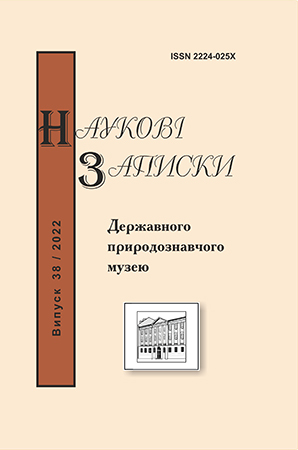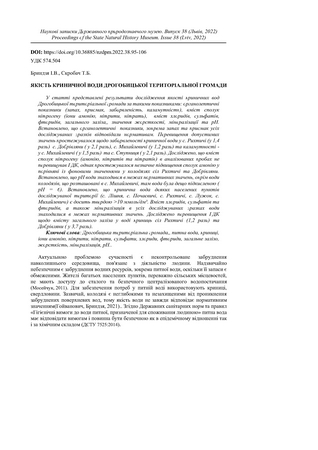Bryndzia I.V., Skrobach T.B.
Well water quality in Drohobych territorial community // Proc. of the State Nat. Hist. Mus. - Lviv, 2022. - 38. - P. 95-106 DOI: https://doi.org/10.36885/nzdpm.2021.38.95-106 Key words: Drohobych territorial community, water, drinking water, wells, ammonium ions, nitrites, nitrates, sulfates, chlorides, fluorides, total iron, hardness, mineralization, pH The article presents the results of the study on the quality of the well waters of the Drohobych territorial community according to the following indicators: organoleptic indicators (smell, flavor, color, pungency), nitrogen compounds content (ammonium ions, nitrites, nitrates), the content of chlorides, sulfates, fluorides, total iron, calcium, the value of hardness, mineralization and pH. It was found that the organoleptic parameters, in particular, the smell and taste of all test samples met the standards. Exceeding the permissible values were detected for the color of well water in the villages Rykhtychi (1.4 times), Dobrivlyany (2.1 times), Mykhailovychi (1.2 times), and turbidity - in the villages Mykhailovychi (1.5 times) and Stupnytsia (2.1 times). It was studied that the content of nitrogen compounds (ammonium, nitrites, and nitrates) in the analyzed samples did not exceed the MPC, but there was a slight increase in ammonium compounds compared to the background values in the wells of the villages of Rychtychi and Dobrivliana. It was found that the pH of the water was within the normative values, except for the water of wells located in the village of Mykhailovychi, where the water was somewhat acidified (pH = 6). Furthermore, it was found that the crystalline water of some settlements in the study area (Lishnya village, Pochaevychi village, Rychtychi village, Luzhok village, Mykhailovychi village) is quite hard 10 mmol/dm³. The content of chlorides, sulfates, and fluorides, as well as mineralization in all water samples tested, were within the normative values. The exceedance of the MPC regarding the content of total iron in the well water of the villages of Rykhtychi (1.2 times) and Dobrivliany (3.7 times) was investigated.
Well water quality in Drohobych territorial community // Proc. of the State Nat. Hist. Mus. - Lviv, 2022. - 38. - P. 95-106 DOI: https://doi.org/10.36885/nzdpm.2021.38.95-106 Key words: Drohobych territorial community, water, drinking water, wells, ammonium ions, nitrites, nitrates, sulfates, chlorides, fluorides, total iron, hardness, mineralization, pH The article presents the results of the study on the quality of the well waters of the Drohobych territorial community according to the following indicators: organoleptic indicators (smell, flavor, color, pungency), nitrogen compounds content (ammonium ions, nitrites, nitrates), the content of chlorides, sulfates, fluorides, total iron, calcium, the value of hardness, mineralization and pH. It was found that the organoleptic parameters, in particular, the smell and taste of all test samples met the standards. Exceeding the permissible values were detected for the color of well water in the villages Rykhtychi (1.4 times), Dobrivlyany (2.1 times), Mykhailovychi (1.2 times), and turbidity - in the villages Mykhailovychi (1.5 times) and Stupnytsia (2.1 times). It was studied that the content of nitrogen compounds (ammonium, nitrites, and nitrates) in the analyzed samples did not exceed the MPC, but there was a slight increase in ammonium compounds compared to the background values in the wells of the villages of Rychtychi and Dobrivliana. It was found that the pH of the water was within the normative values, except for the water of wells located in the village of Mykhailovychi, where the water was somewhat acidified (pH = 6). Furthermore, it was found that the crystalline water of some settlements in the study area (Lishnya village, Pochaevychi village, Rychtychi village, Luzhok village, Mykhailovychi village) is quite hard 10 mmol/dm³. The content of chlorides, sulfates, and fluorides, as well as mineralization in all water samples tested, were within the normative values. The exceedance of the MPC regarding the content of total iron in the well water of the villages of Rykhtychi (1.2 times) and Dobrivliany (3.7 times) was investigated.
References
- Гойванович Н., Бриндзя І., Івасівка А. 2021. Моніторинг якості криничних вод Старосамбірського району Львівщини. Екологічні науки. Вип. 7(34). 151-156. DOI: https://doi.org/10.32846/2306-9716/2021.eco.7-34.25.
- Гойванович Н.К., Бриндзя І.В. 2021. Моніторинг якості криничних вод Жидачівського району Львівської області. Наукові записки Державного природничого музею. Вип. 37. С. 105–115. DOI: https://doi.org/10.36885/nzdpm.2021.37.105-114
- Грюк І., Суходольська І. 2012. Вміст сполук нітрогену у воді малих річок як показник рівня антропогенного навантаження територій. Вісник Львівського університету. Серія біологічна. Вип. 60. С. 227–238.
- ДСТУ 7525:2014. «Вода питна. Вимоги та методи контролювання якості». Київ : Мінекономрозвитку України. 25 с.
- Коткова Т.М., Федючка М.І., Карась І Ф. 2018. Екологічна оцінка питної води Лугинського району Житомирської області на вміст хлоридів, сульфатів та нітратів. Науковий вісник НЛТУ України. Т. 28, № 7. С. 83–87. https://doi.org/10.15421/40280718.
- Мосейчук А.А. 2011. Оцінка якості питної води в джерелах децентралізованого водопостачання Полтавської області. Вісник Полтавської державної аграрної академії. № 4. С. 12‒17.
- Сафранов Т.А. 2018. Мінералізація питних вод як показник їх якості та фактор впливу на здоров'я населення. Людина та довкілля. Проблеми неоекології. № 1-2 (29). С. 73–80. DOI: 10.26565/1992-4224-2018-29-08
- Сігалова І.О., Присяжнюк Л.М. 2016. Стан питного водопостачання м. Біла Церква за впливу промислового виробництва. Вид-во ЖДУ ім. І. Франка. Житомир. С. 217–221.
- Сухарева О.Ю., Делеган-Кокайко С.В., Макарович Т.В., Сухарев С.М., Коваль Г.М. 2017. Якість питної води децентралізованих джерел водопостачання мікрорайону Горяни. Науковий вісник Ужгородського університетуту. Серія Хімія. № 1 (37). С. 79–85.
- Чернега А.М., Іщенко В.А. 2016. Дослідження складу питної води з джерел децентралізованого водопостачання. Вісник Вінницького політехнічного інституту. Вінниця. № 4. С. 32–35.


